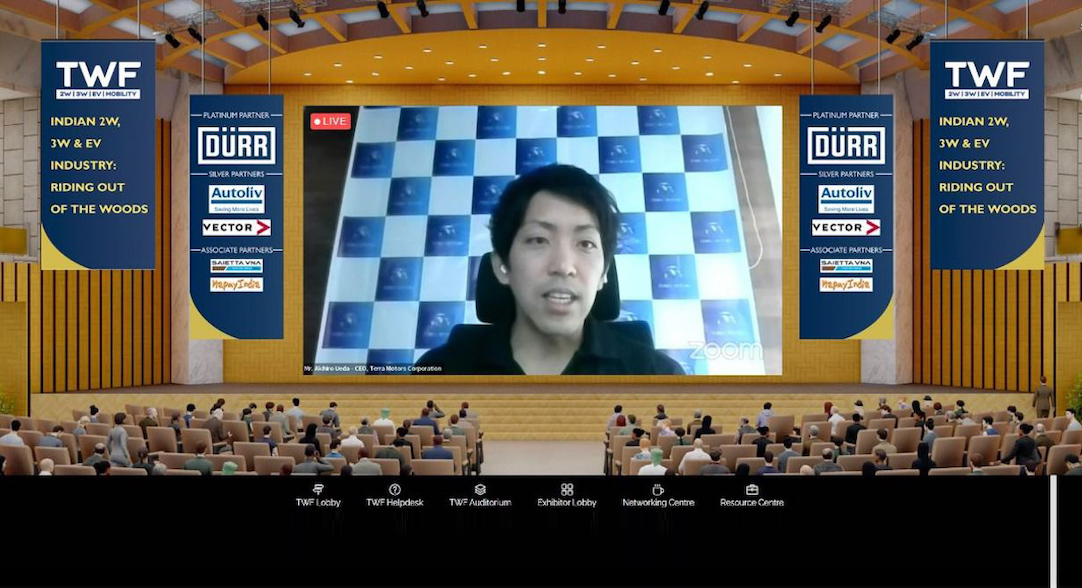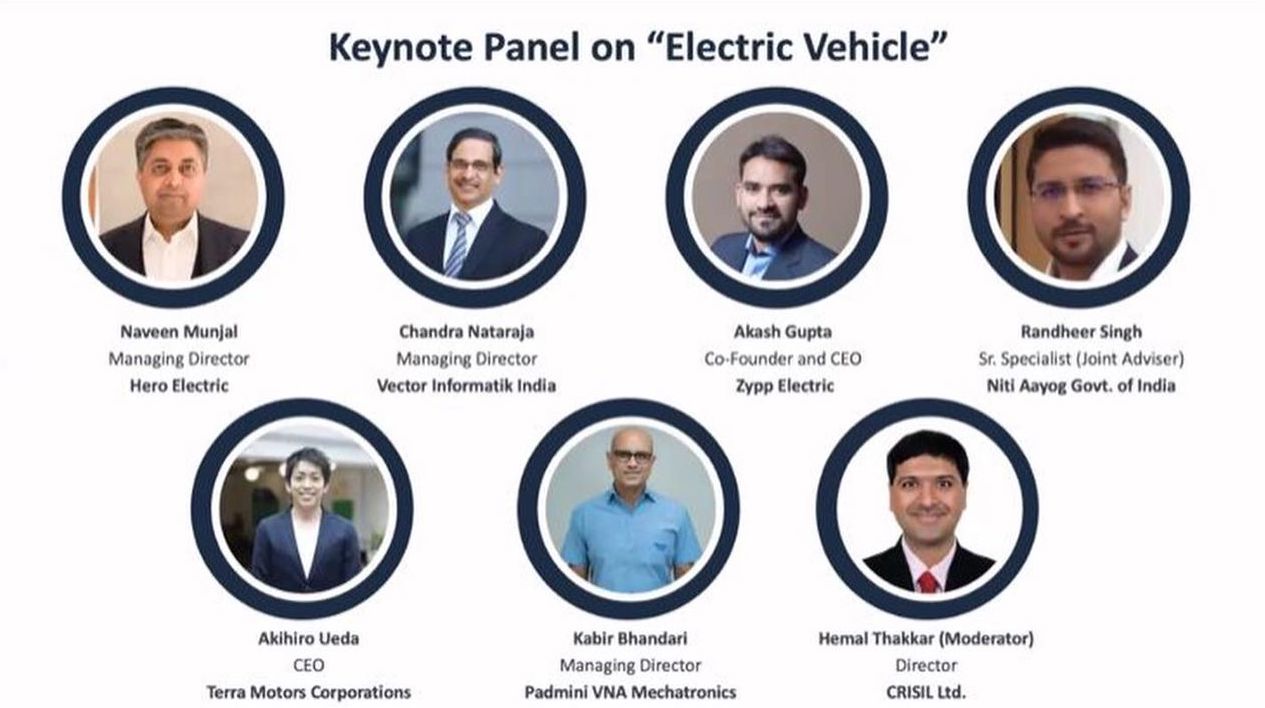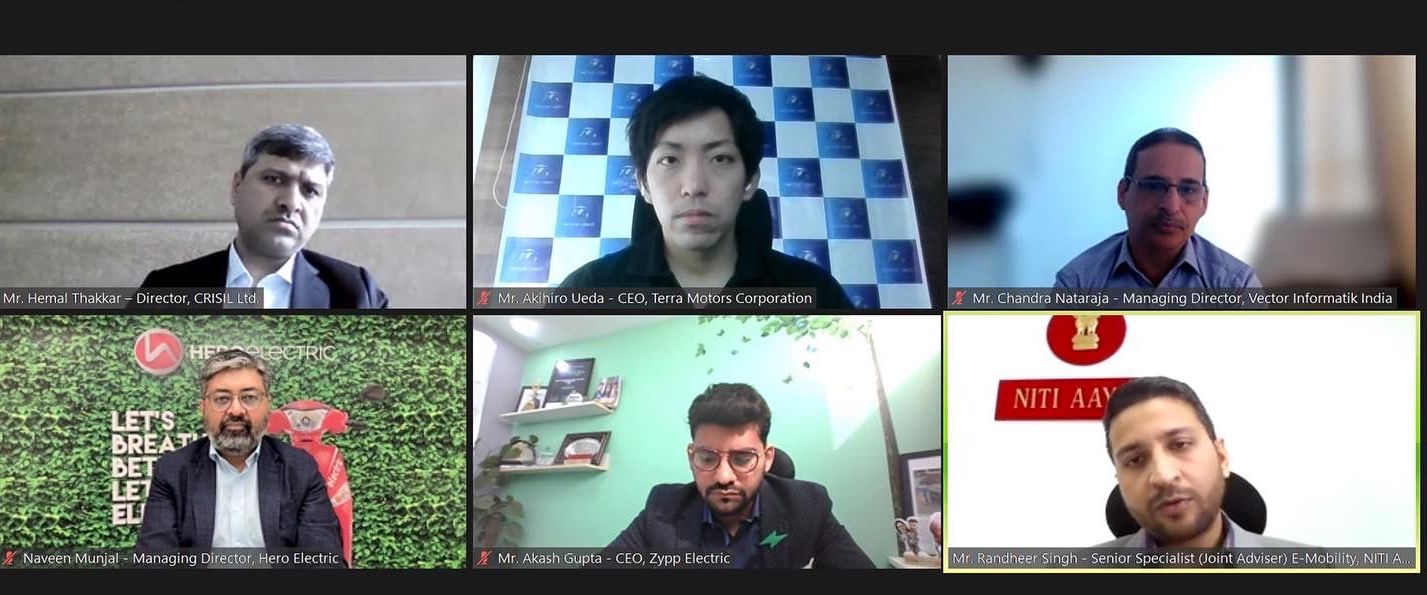
Report: The virtual event of panel discussion, organised by TWF (2W, 3W & EV forum) 2021
15 Dec 2021
A virtual event of panel discussion, organised by TWF (2W, 3W & EV forum), was held on 9th and 10th December 2021. TWF brought together some of the biggest & brightest names of the 2W, 3W & EV space to speak in the panel discussion. Mr. Akihiro Ueda, CEO at Terra Motors Corporation, was one of them. The panel discussion involved the discussion of the Indian 2W industry, connectivity systems and predictive analytics, research presentation on the electric vehicle ecosystem, electric vehicles, battery-connectivity, charging, cost and disposal. The moderator of the panel discussion was Hemal Thakkar, Director, Crisil Ltd.

Participants in the panel discussion were as follows:
1. Hemal Thakkar - Director, CRISIL Ltd. (Moderator of the event)
2. Akihiro Ueda - CEO, Terra Motors Corporation
3. Chandra Nataraja- Managing Director,Vector Informatik India
4. Naveen Munjal- Managing Director, Hero Electric
5. Akash Gupta - Co-founder and CEO, Zypp Electric
6. Randheer Singh - Sc. Specialist, Joint Advisor (Niti Aayog Govt. of India)

Here is a partial summary of the panel discussion
Summary: Panel Discussion on Electric Vehicle
The EV industry has been booming over the last couple of months. Since fuel prices have crossed 100 rupees, we can see the transition at a faster pace. It is contributing to the socio and economic parameters of the country. Over a period of time, the performance of EV, there was a lot of ambiguity and now it is going away. We can also see, with improvement in battery technology, with charging infrastructure coming up, the adoption is faster and faster. There are places where there is no infrastructure for batteries hence, it is creating range anxiety. There are some places where the growth is still bleak.Mr. Naveen Manjhar - Managing Director, Hero Electric
"We have to start working on mobility," said Naveen Munjal. After which the focus can be shifted towards working on 2 wheeler and 3 wheeler. According to him, there are various reasons why that's going to convert. Firstly, India is a large two wheeler market, 80% of the vehicles on the whole arc are two wheelers. Secondly, when we look at from a perspective of price parities, the prices with the new policies in place have cut down the initial purchase prices. Finally, the total cost of ownership, the gap between the IC engine and electric vehicle, that gap has hugely widened in favour of electric mobility. These factors are catapulting the hold market to go to drastic growth. Meanwhile, there are a number of factors that we need to keep an account for. When we look at the infrastructure we need to divide it into categories; two wheelers, three wheelers, cars, public transport, commercial vehicles etc.All have different needs and infrastructure requirements and all will take off at different stages in terms of timeline. All of them have to have different deadlines when it comes to conversion to electric from IC engines. The base of the pyramid is going to be two wheelers because of the factors. For small electric vehicles we do not need high powered charging infrastructure but we need dense and a very basic charging infrastructure which will help cut down the cost. To make the batteries convenient for the users, the batteries have been developed entirely portable across the entire product range. If there is no charging infrastructure nearby your area then the batteries can be handy. However, there still remains some range and IT issues. This is the issue that needs to be addressed.
The infrastructure must come before mobility makes its way in between. "We are looking for collaborators and trying to develop 10,000 and more charging stations. The other factor is financing. The problem faced due to financing was till June 2021, 70% of the market was actually a low speed market. With those vehicles financing was challenging because they were unregistered, difficult to determine the resale or end of the value of the vehicle. Post June, with the change in the policy, the market has dramatically shifted towards city speed vehicles. Now the customers are buying the registered vehicles and financing opportunities are also available.
Mr. Randheer Singh - Sc. Specialist, Joint Advisor, Niti Aayog Govt. of India
The requirement in India is huge, which is why people can see the potential of EV and they are coming with technology. This is a technology agnostic PLI, there are two parameters to be fulfilled; cycle life and watt hour per kg (battery density). Meeting the criteria will qualify the companies for the technology, giving them bonus advantages. There is an incentive inbuilt for people to move from obsolete technology.In 1991, lithium ion batteries were commercialised. There is a price reduction of 97% since 1991 till 2020. This era needs to be divided into two parts: 1991-2016 and 2016-2020.
During 1991-2016, the learning curve for battery technology: cylindrical cells was 24% and for other cells was 20%. Post 2016, anti-government and everyone started focusing on the electrical vehicles. The learning curve of other cells increased to 27% and for cylindrical cells it increased to 31%. The price reduction per year was 13%. However, from 2016-2020, this reduction was 17%. This shows that the world is dynamic. We are at the inflexion point. Right now, two wheelers and three wheelers combined with the Federal and the State incentives are at the capex level, at the upfront cost level, at par or at the cheap level with battery.
In Fintex, we are using many platforms and social media to build the credit history of the first time buyers and also the people who cannot put collateral. There are buy back programs and captive financing is coming up and boosting the finance. The first loss sharing with the government will also be coming up.
Within the ECC, we have released a document sharing the testing parameters and conditions. There must be standard labs available for testing with the required materials so that the testing can be done within a given timeline.
Mr. Akihiro Ueda - CEO, Terra Motors India Ltd.,

Is EV coming to our lives which is next to us? "The answer is no", said Mr Akhiro Ueda.
According to him, communication to the market is lacking. The customer would want to know how much they can save if they switch to electric vehicles. This information must be communicated to the market clearly.
Infrastructure (Ecosystem) is not only the charging station, we need to know the location, availability of the battery and security of the battery. Another important factor for EV is finance. As it is one of the keys to boost up the EV industry by supporting and encouraging people to purchase EV. We also want to provide opportunities to people to use EV as a commercial vehicle which will eventually help the business and hedge the risk of financing.